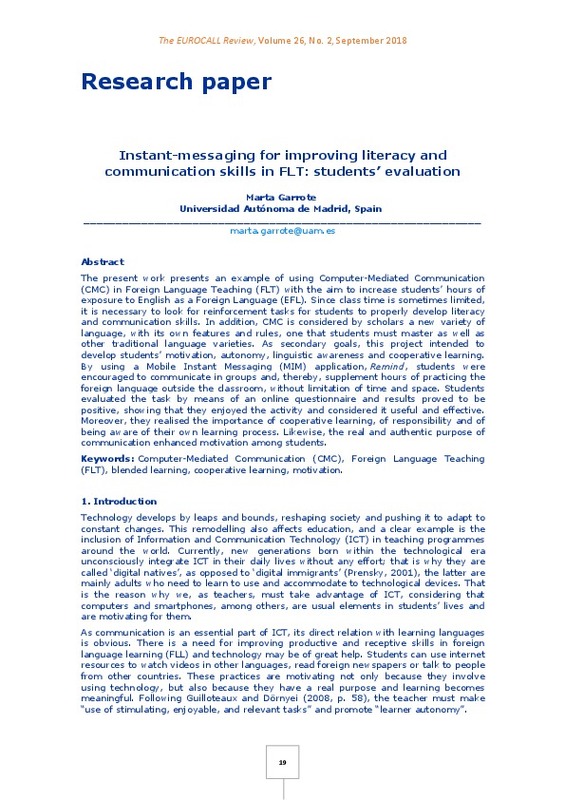Baepler, P., Walker, J. D. and Driessen, M. (2014). It's not about seat time: Blending, flipping, and efficiency in active learning classrooms. Computers & Education, 78, 227-236. https://doi.org/10.1016/j.compedu.2014.06.006
Baron, N. (2008). Always on: Language in an Online and Mobile World. Oxford: Oxford University Press. https://doi.org/10.1093/acprof:oso/9780195313055.001.0001
Barton, D. and Lee, C. (2013). Language Online: Investigating Digital Texts and Practices. London: Routledge. https://doi.org/10.4324/9780203552308
[+]
Baepler, P., Walker, J. D. and Driessen, M. (2014). It's not about seat time: Blending, flipping, and efficiency in active learning classrooms. Computers & Education, 78, 227-236. https://doi.org/10.1016/j.compedu.2014.06.006
Baron, N. (2008). Always on: Language in an Online and Mobile World. Oxford: Oxford University Press. https://doi.org/10.1093/acprof:oso/9780195313055.001.0001
Barton, D. and Lee, C. (2013). Language Online: Investigating Digital Texts and Practices. London: Routledge. https://doi.org/10.4324/9780203552308
Bekleyen, N. and Yilmaz, A. (2012). The impact of Computer-Assisted Language Learning on vocabulary teaching: JingTM and instant messaging. Education Sciences, 7(1), 419-425.
Benson, P. (2011). Language learning and teaching beyond the classroom: An introduction to the field. In P. Benson and H. Reinders (Eds.), Beyond the language classroom (pp. 7-16). London: Palgrave Macmillan. https://doi.org/10.1057/9780230306790
Bieswanger, M. (2013). Micro-linguistic structural features of computer-mediated communication. In S. Herring, D. Stein, and T. Virtanen (Eds.), Pragmatics of computer-mediated communication, 9 (pp. 463-488). Berlin/Boston: Walter de Gruyter.
Council of Europe (2001). Common European Framework of Reference for Languages: learning, teaching, assessment. Cambridge: Cambridge University Press.
Crystal, D. (2001). Language and the Internet. Cambridge: Cambridge University Press. https://doi.org/10.1017/CBO9781139164771
Crystal, D. (2006). Language and the Internet. Cambridge: Cambridge University Press. https://doi.org/10.1017/CBO9780511487002
Csizér, K., & Dörnyei, Z. (2005). The internal structure of language learning motivation and its relationship with language choice and learning effort. The modern language journal, 89(1), 19-36. https://doi.org/10.1111/j.0026-7902.2005.00263.x
Georgakopoulou, A. (2011). Computer-mediated communication. In J. Östman and J. Verschueren (Eds.), Pragmatics in Practice. John Benjamins, pp. 93-110. https://doi.org/10.1075/hoph.9.05geo
Goker, S. D. (2006). Impact of peer coaching on self-efficacy and instructional skills in TEFL teacher education. System, 34(2), 239-254. https://doi.org/10.1016/j.system.2005.12.002
Gómez, D. S. and Shafirova, L. (2016). Conversación en WhatsApp: aprendizaje y colaboración en lingua franca. Bellaterra Journal of Teaching & Learning Language & Literature, 9(4), 23-40. https://doi.org/10.5565/rev/jtl3.669
Graham, C. R. (2006). Blended learning systems. In C. J. Bonk and C. R. Graham (Eds.), The handbook of blended learning: Global perspectives, local designs (pp. 3-21). San Francisco: Pfeiffer Publishing.
Guilloteaux, M. J. and Dörnyei, Z. (2008). Motivating language learners: A classroom‐oriented investigation of the effects of motivational strategies on student motivation. TESOL Quarterly, 42(1), 55-77. https://doi.org/10.1002/j.1545-7249.2008.tb00207.x
Herring, S.C. (2008). Language and the Internet. The International Encyclopedia of Communication. https://doi.org/10.1002/9781405186407
Herring, S. C. (2010). Computer-mediated conversation, Part I: Introduction and overview. Language@Internet, 7(2), 12-31.
Herring, S. C. (2011). Computer-mediated conversation, Part II: Introduction and overview. Language@Internet, 8(2), 12-24.
Herring, S. C. (2012). Grammar and electronic communication. In C. A. Chapelle (Ed.), The encyclopedia of applied linguistics. Retrieved from: https://onlinelibrary.wiley.com/doi/10.1002/9781405198431.wbeal0466. https://doi.org/10.1002/9781405198431.wbeal0466
Hrastinski, S. (2008). Asynchronous and synchronous e-learning. Educause quarterly, 31(4), 51-55.
Koh, J. H. L., Herring, S. C. and Hew, K. F. (2010). Project-based learning and student knowledge construction during asynchronous online discussion. Internet and Higher Education, 13(4), 284-291 https://doi.org/10.1016/j.iheduc.2010.09.003
Newmaster, S., Lacroix, C. A. and Roosenboom, C. R. (2006). Authentic learning as a mechanism for learner centredness. International Journal of Learning, 13(6), 103-112. https://doi.org/10.18848/1447-9494/CGP/v13i06/44916
Piaget, Jean. (1973). To Understand is to Invent. New York: Grossman.
Powell, K. C. and Kalina, C. J. (2009). Cognitive and social constructivism: Developing tools for an effective classroom. Education, 130(2), 241-250.
Prensky, M. (2001). Digital natives, digital immigrants. On the Horizon, 9(5), 1-4. https://doi.org/10.1108/10748120110424816
Rosen, D., Woelfel, J., Krikorian, D. and Barnett, G. A. (2003). Procedures for analyses of online communities. Journal of Computer‐Mediated Communication, 8(4), 0-0. https://doi.org/10.1111/j.1083-6101.2003.tb00219.x
Slomanson, W. R. (2014). Blended learning: A flipped classroom experiment. Journal of Legal Education, 64(1), 93-102.
Sotillo, S. M. (2006). Using instant messaging for collaborative learning: A case study. Innovate: Journal of Online Education, 2(3), Article 2.
Thomas, J. W. (2000). A review of research on project-based learning. San Rafael, CA: Autodesk Foundation.
Vygotsky, L. S. (1962). Thought and language. Cambridge, MA: MIT Press. https://doi.org/10.1037/11193-000
Wang, L. (2005). The advantages of using technology in Second Language Education. T.H.E. Journal, 32(10), 38-42.
Waninge, F., Dörnyei, Z. and De Bot, K. (2014). Motivational Dynamics in Language Learning: Change, Stability, and Context. The Modern Language Journal, 98(3), 704-723. https://doi.org/10.1111/modl.12118
Warner, C. N. (2004). It's just a game, right? Types of play in foreign language CMC. Language Learning & Technology, 8(2), 69-87.
[-]







![HTML file [HTML]](/themes/UPV/images/html.png)

